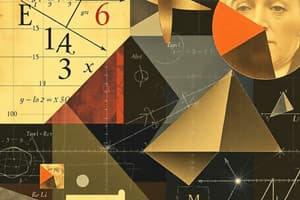Podcast
Questions and Answers
Which property holds true for addition and multiplication?
Which property holds true for addition and multiplication?
- Commutative Property (correct)
- Associative Property (correct)
- Distributive Property
- Identity Property
In a right triangle, which trigonometric function relates the opposite side to the adjacent side?
In a right triangle, which trigonometric function relates the opposite side to the adjacent side?
- Sine
- Cosine
- Tangent (correct)
- Secant
What is the area formula for a rectangle?
What is the area formula for a rectangle?
- 2 x (Length + Width)
- Length + Width
- Length x Width (correct)
- Base x Height
What is the fundamental concept behind calculus that describes the behavior of functions?
What is the fundamental concept behind calculus that describes the behavior of functions?
Which measure of central tendency is most affected by extreme values in a data set?
Which measure of central tendency is most affected by extreme values in a data set?
Which branch of mathematics focuses on the study of discrete elements like graphs?
Which branch of mathematics focuses on the study of discrete elements like graphs?
What is the correct statement for the Pythagorean theorem?
What is the correct statement for the Pythagorean theorem?
Which reasoning method involves starting from specific observations to form a general conclusion?
Which reasoning method involves starting from specific observations to form a general conclusion?
Flashcards are hidden until you start studying
Study Notes
Key Areas of Mathematics
1. Arithmetic
- Basic operations: addition, subtraction, multiplication, division
- Properties: commutative, associative, distributive
- Integers, fractions, decimals, percentages
2. Algebra
- Variables and constants
- Expressions and equations
- Linear equations (e.g., y = mx + b)
- Polynomials, factoring, and quadratic equations
- Functions and their graphs
3. Geometry
- Basic shapes: triangles, circles, rectangles, polygons
- Area and perimeter formulas
- Volume and surface area of 3D shapes (cylinders, spheres, cubes)
- The Pythagorean theorem
4. Trigonometry
- Definitions of sine, cosine, and tangent
- Right triangle relationships
- Unit circle concepts
- Trigonometric identities (e.g., Pythagorean identities)
5. Calculus
- Limits and continuity
- Derivatives: definitions and applications
- Integrals: definite and indefinite
- Fundamental Theorem of Calculus
- Applications in physics, biology, and economics
6. Statistics
- Types of data: qualitative vs. quantitative
- Measures of central tendency: mean, median, mode
- Measures of dispersion: range, variance, standard deviation
- Probability concepts: independent vs. dependent events, conditional probability
7. Discrete Mathematics
- Set theory: definitions and operations (union, intersection)
- Combinatorics: permutations and combinations
- Graph theory: vertices, edges, paths, and circuits
- Logic: propositions, truth tables, and logical operators
8. Mathematical Reasoning
- Inductive and deductive reasoning
- Proof techniques: direct, indirect, contradiction
- Mathematical induction
- Problem-solving strategies
Important Concepts
- Mathematical modeling
- Number theory: primes, factors, and divisibility
- The role of mathematics in the sciences and everyday life
Tools & Techniques
- Calculators and computers for computation
- Graphing tools for visual representation
- Statistical software for data analysis
Study Tips
- Practice regularly to reinforce concepts.
- Use visual aids (diagrams, graphs) for better understanding.
- Work on a variety of problems to build a strong foundation.
- Collaborate with peers for different perspectives and explanations.
Arithmetic
- Basic operations: addition, subtraction, multiplication, and division
- Properties of addition, subtraction, multiplication and division: commutative, associative, and distributive
- Working with Integers, fractions, decimals, and percentages
Algebra
- Understanding the difference between variables and constants
- Writing and solving expressions and equations
- Working with linear equations, including the slope-intercept form (y = mx + b)
- Factoring polynomials and solving quadratic equations
- Understanding functions and their graphs
Geometry
- Recognizing and working with basic shapes including triangles, circles, rectangles, and polygons
- Calculating area and perimeter of various shapes
- Knowing how to calculate the volume and surface area of 3D shapes, such as cylinders, spheres, and cubes
- Appling the Pythagorean theorem to find missing sides of right triangles
Trigonometry
- Defining sine, cosine, and tangent
- Understanding right triangle relationships using SOH CAH TOA
- Familiarizing with unit circle concepts
- Recognizing common trigonometric identities (e.g., Pythagorean identities)
Calculus
- Understanding the concept of limits and continuity
- Defining and applying derivatives
- Defining and calculating definite and indefinite integrals
- Knowing the Fundamental Theorem of Calculus
- Recognizing applications of calculus in various fields, such as physics, biology, and economics
Statistics
- Distinguishing between qualitative and quantitative data
- Calculating measures of central tendency including mean, median, and mode
- Determining measures of dispersion such as range, variance and standard deviation
- Understanding probability concepts, including independent and dependent events, as well as conditional probability
Discrete Mathematics
- Working with set theory concepts and operations, including union and intersection
- Applying combinatorics to calculate permutations and combinations
- Understanding the fundamentals of graph theory, including vertices, edges, paths, and circuits
- Applying logic to evaluate propositions, truth tables, and logical operators
Mathematical Reasoning
- Distinguishing between inductive and deductive reasoning
- Knowing various proof techniques: direct, indirect, and contradiction
- Using mathematical induction to prove statements
- Applying problem-solving strategies to tackle mathematical challenges
Important Concepts
- Understanding mathematical modeling
- Working with number theory concepts including primes, factors, and divisibility
- Recognizing the role of mathematics in various fields of science, as well as everyday life
Tools & Techniques
- Utilizing calculators and computers for computations
- Employing graphing tools for visual representation
- Using statistical software for data analysis
Study Tips
- Practicing regularly to reinforce concepts
- Using visual aids (diagrams and graphs) to enhance understanding
- Solving a variety of problems to build a strong foundation
- Collaborating with peers to gain different perspectives and explanations.
Studying That Suits You
Use AI to generate personalized quizzes and flashcards to suit your learning preferences.




